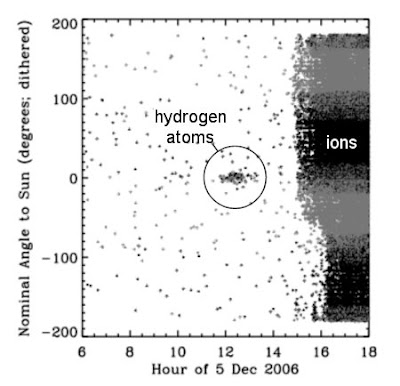New Image Shows the Power of Visual Remix
The same way a visible-light photographer can choose to shoot black and white instead of color, astronomers using NASA's Spitzer Space Telescope have their choice of what colors to use or not use in their images, as shown in an image of star-forming region RCW 49 released today.
The new picture is an alternate view of a dusty stellar nursery located 13,700 light-years away in the southern constellation Centaurus. Spitzer released its original version of the image in 2004. That image combined information from four different wavelengths of infrared light, but the new image uses only two.
The typical human eye perceives three different colors of visible light -- red, green, and blue -- with cones on the retina. All the colors we see are made up of some combination of these three colors. Every color of light has a different wavelength, and many wavelengths fall outside the visible spectrum. Infrared light is basically wavelengths of light that vibrate at colors below the red part of the spectrum, colors we can't see.
Spitzer's two imaging cameras effectively see a total of seven different wavelengths, or channels, of infrared light. That would be the equivalent of the eye being sensitive to seven colors instead of just three. The challenge for Spitzer imaging scientists is to present all these different channels using colors that we can see. When astronomers select which channels to include in their false-color composites, each wavelength is assigned a different visible-light color. Therefore, the same observations can be used to make very different images.
Spitzer's two shortest wavelengths, 3.6 microns and 4.5 microns, were mapped as cyan and red respectively for the new image. At 4.5 microns, hot hydrogen gas glows very brightly, much like a neon light glowing in visible light. The two-channel image therefore emphasizes hot hydrogen gas, which shows up as the red regions, in addition to the more than 2,200 stars and organic molecules visible in both the two-channel and four-channel images.
As well as enabling exciting new science discoveries, two-channel images like this one are particularly interesting to scientists who wish to understand how Spitzer will perform after its liquid helium coolant runs out in 2009. At this time the telescope will become too warm to observe at longer wavelengths, but will continue to operate in these channels.
The new picture is an alternate view of a dusty stellar nursery located 13,700 light-years away in the southern constellation Centaurus. Spitzer released its original version of the image in 2004. That image combined information from four different wavelengths of infrared light, but the new image uses only two.
The typical human eye perceives three different colors of visible light -- red, green, and blue -- with cones on the retina. All the colors we see are made up of some combination of these three colors. Every color of light has a different wavelength, and many wavelengths fall outside the visible spectrum. Infrared light is basically wavelengths of light that vibrate at colors below the red part of the spectrum, colors we can't see.
Spitzer's two imaging cameras effectively see a total of seven different wavelengths, or channels, of infrared light. That would be the equivalent of the eye being sensitive to seven colors instead of just three. The challenge for Spitzer imaging scientists is to present all these different channels using colors that we can see. When astronomers select which channels to include in their false-color composites, each wavelength is assigned a different visible-light color. Therefore, the same observations can be used to make very different images.
Spitzer's two shortest wavelengths, 3.6 microns and 4.5 microns, were mapped as cyan and red respectively for the new image. At 4.5 microns, hot hydrogen gas glows very brightly, much like a neon light glowing in visible light. The two-channel image therefore emphasizes hot hydrogen gas, which shows up as the red regions, in addition to the more than 2,200 stars and organic molecules visible in both the two-channel and four-channel images.
As well as enabling exciting new science discoveries, two-channel images like this one are particularly interesting to scientists who wish to understand how Spitzer will perform after its liquid helium coolant runs out in 2009. At this time the telescope will become too warm to observe at longer wavelengths, but will continue to operate in these channels.
Object type: Star Formation
Position (J2000): RA: 10h 24m 14.60s Dec: -57° 46' 58.00"
Instrument: IRAC
Wavelength: 3.6 Micron (Cyan), 4.5 Micron (Red)





















